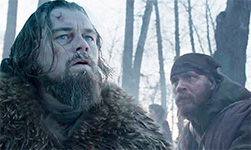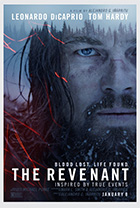The Revenant
|  Alejandro G. Iñárritu’s The Revenant is a singular cinematic experience of profound visceral impact. Unlike his Oscar-winning Birdman (2014), which indulged in a single-shot aesthetic for reasons that felt more experimental and daring for its own sake than thematically or narratively justified, the intense realism of The Revenant and the extreme lengths to which Iñárritu and cinematographer Emmanuel Lubezki (The Tree of Life) went to achieve it feel both fully earned and absolutely necessary. Alejandro G. Iñárritu’s The Revenant is a singular cinematic experience of profound visceral impact. Unlike his Oscar-winning Birdman (2014), which indulged in a single-shot aesthetic for reasons that felt more experimental and daring for its own sake than thematically or narratively justified, the intense realism of The Revenant and the extreme lengths to which Iñárritu and cinematographer Emmanuel Lubezki (The Tree of Life) went to achieve it feel both fully earned and absolutely necessary.This is a film that, above all, makes you feel in both the physical and the emotional senses. The long takes, the undeniable verisimilitude of the locations, and the dynamic performances by the actors make us feel the bitter cold, the icy isolation, the intense pressure, the panic, the fear, the awe. It is actually better for not trying to achieve anything like a grand theme or underlying social subtext. It is a film of surface, texture, and experience, something that would seem oh-so-typical in today’s world of CGI blockbusters; however, seeing The Revenant reveals once again how important the maintenance of photographic realism is to the cinematic experience and how our increasing reliance on pixels to stand in for the real world is sapping the art of its vitality. The film is based in part on Michael Punke’s 2002 novel, which is a fictionalized account of the experiences of an early 19th-century frontiersman and fur trapper named Hugh Glass, who was mauled by a grizzly bear while fur trapping in the watershed of the Upper Missouri River and eventually left for dead by his companions. The story of Glass’s unlikely survival and determination to exact revenge on those who deserted him was the stuff of frontier folk legend for years, and it has previously been novelized by Frederick Manfred in 1954 as Lord Grizzly, adapted as a part of the television anthology Death Valley Days in 1966, and made into a feature film, 1971’s Man in the Wilderness starring Richard Harris and John Huston. Thus, Iñárritu is not treading new ground in dramatizing Glass’s ordeal, but what he has done is utilize in all the best ways possible the various tools of the cinema to bring that ordeal to life in a way that has never been done before. Make no mistake, The Revenant is a film of great intensity, nearly relentless in its depiction of the difficulties involved in a single human being trying to survive in the great American wilderness with nothing more than his knowledge and sheer determination. As played by Leonardo DiCaprio, Glass is a kind of grizzled romantic who has accepted the job of guiding a military-escorted party of fur trappers through the largely uncharted wilds of South Dakota for the Rocky Mountain Fur Company. Glass is supplied with a fictional backstory, told in evocative, fragmentary flashbacks scattered throughout the film, in which he became involved with a Native American woman, lived with her tribe for many years, and fathered a son, Hawk (Forrest Goodluck), who is now a teenager and travels with him. His wife and her village were destroyed by the U.S. military, thus establishing the fundamental tension between the Native Americans and the encroaching white explorers and settlers. This tension is threaded throughout the film, beginning with an attack in the opening scene by a band of Arikara Native Americans who are searching for the chief’s kidnapped daughter, Powaqa (Melaw Nakehk’o). The attack kills most of the trappers and soldiers, leaving behind a rag-tag group of survivors who must try to make their way back to a settlement before they are killed by either the Arikara or the brutal winter. Among the survivors are Captain Andrew Henry (Domhall Gleeson), a man of good character put in a nearly impossible situation, and John Fitzgerald (Tom Hardy), a surly, quite possibly sociopathic trapper who resents Glass and his “half-breed son.” After Glass is attacked and mauled by a grizzly bear when he happens upon her cubs while hunting, most of the men in the party assume that he will not be able to survive his numerous injuries. The bear attack is one of the film’s numerous, jaw-dropping highlights, as Iñárritu depicts it in a single, unbroken take that seamlessly merges a real environment, a computer-generated bear, and an intensely physical performance by DiCaprio that conveys both the horrific pain and terror of being literally torn apart by grizzly claws and teeth and the willpower to keep fighting for his life. Captain Henry, who has some medical training, sews him up as best he can and orders that he be carried with them on a makeshift stretcher, even though Fitzgerald grumbles that they should just put him out of his misery. Glass is so badly wounded that he cannot speak (part of his throat has been ripped out), and he is essentially immobilized on the stretcher, thus denying him any ability to communicate outside of his eyes. When the party comes to an impasse through which they cannot carry Glass, they decide to leave him behind with two men with the idea that they will return once they reach the settlement and can bring back more men and supplies. Unfortunately, one of the men who volunteers to stay behind is Fitzgerald, and when Hawk tries to stop him from deserting his father, Fitzgerald kills him in front of Glass and then half-buries Glass in a shallow grave, assuming he will simply die of exposure. However, Fitzgerald vastly underestimates Glass’s determination to survive, and when he claws his way out of the freezing dirt and begins crawling back toward the settlement, he has truly become the “revenant” of the title—a medieval term for a ghost or reanimated corpse that returns to torment the living. As Glass later says, “I ain’t afraid of dying. I already died once.” In a way, though, Glass has died numerous times—first when his wife was killed, then when his son was killed, and finally when he was all but left for dead. Spiritually, physically, and emotionally, he has been decimated by exterior forces he was unable to counteract, which leaves him a hardened shell of a man, clawing toward the only thing left for him to grasp: vengeance. In a way, he and Fitzgerald, the object of his wrath, essentially become one in the same, as Fitzgerald, who has already been the victim of a scalping, notes several times that he has nothing to live for and is not afraid to die. When death no longer holds its sting, one must question whether humanity still exists. The screenplay by Mark L. Smith (Vacancy) and Iñárritu is deliberately straightforward and unfussy. Aside from the various flashbacks, some of which play like dreams and nightmares, the story has a relentless forward march, cutting among Glass’s painful trek after Fitzgerald; Captain Henry, Fitzgerald, and the others making their way back to the settlement; and the band of Arikara led by Hikuc (Arthur RedCloud) as they continue searching for his daughter and trade with a group of French trappers. At times there is little dialogue, which emphasizes the film’s immense visual nature (this should have been shot in Ultra Panavision 65, rather than Tarantino’s snowbound The Hateful Eight). Shot in three different countries (Canada, the American Northwest, and Argentina) using only natural light, The Revenant conveys the same sense of terrible awe that one finds in the best of Werner Herzog’s films, particularly Aguirre: The Wrath of God (1972), which was similarly made under great duress in the actual wilderness. The capital-W “Wilderness” has long been an overly romanticized notion in American literature, particularly by writers like Walt Whitman and Henry David Thoreau, and while there are no doubt moments of magisterial beauty throughout The Revenant, it primarily conveys the awful grandeur of a landscape that cares nothing about humans and their petty problems. There are several points where Iñárritu introduces an element of nature—I’m thinking particularly of a buffalo stampede and the pursuit by a pack of ravenous wolves and a sudden avalanche—that in another film would become the next big hurdle for the protagonist to mount, but here is presented as simply nature in action. When a film turns every natural occurrence into a narrative obstacle, it subverts the natural world to human plight, whereas Iñárritu is clearly conveying the opposite: the wilderness will do what it does regardless of Glass’s or anyone else’s presence. Long after he is gone, the mountains and the trees and the rivers will continue, and The Revenant is a powerful, at times excruciating depiction of that relationship. Copyright ©2016 James Kendrick Thoughts? E-mail James Kendrick All images copyright © 20th Century Fox |
Overall Rating: 


 (4)
(4)


